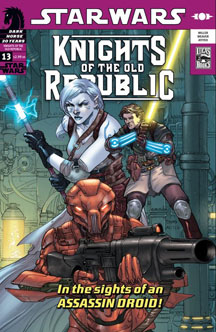I prefer reading “Star Wars” comics in trade-paperback volumes rather than on a monthly basis because I find the story flows better. The 2007 batch of “Knights of the Old Republic,” comprising Issues 13-24, goes against the grain, though.
This is a deliberately paced section of the saga, with the Arkanian villain Lord Adasca regularly repeating his scheme to take over the galaxy by leveraging the fact that he can control exogorths (space slugs, most famously seen in “Empire Strikes Back”). That’s not automatically a bad thing, as sometimes I enjoy slowing down and savoring a “Star Wars” yarn, and John Jackson Miller is still an outstanding character writer, but it’s undeniable he’s treading water a bit on these issues.
A big point in favor of the exogorth scheme is it feels like “Tales of the Jedi,” the series that immediately precedes “Knights” on the Legends timeline. Too often, “Knights” seems like it could take place anywhere on the timeline, but it starts to develop a bit of a “Tales” feel here with the sweeping Republic versus Mandalorian war and the way it delves into the backstory of a small piece of the classic films, the space slugs. (Similarly, the “Tales” saga dug into the history of Yavin’s Massassi Temples and the way hyperspace routes are discovered.)
In my last “Knights” post, I observed that Miller had assembled a “Firefly”-style crew, but he breaks it up in Issue 13, leaving a reader (and even Zayne, who says “I would have preferred some company” as Jarael takes off) to hope everyone will get back together at some point.
Much to Zayne’s bafflement, Gryph somehow starts a successful restaurant serving Republic military camps. An amusing addition to the brotherhood of the sorta-brave is Slyssk, a rare Trandoshan who is averse to killing, and who happens to be an amazing chef. For all the entertainment value of the makeshift restaurateurs, it’s annoying that Zayne has to deal with even more people who want to lock him up for his masters’ murders of Jedi Padawans. At least Republic Lieutenant Onasi is capable of judging Zayne by his character rather than the official reports.
In the 2006 batch, Miller tried to make Lucien (Zayne’s master) sympathetic by showing his training by Master Krynda, and the author tries the same tack with Lucien’s fellow Padawan-murderer Raana Tey here. By the end of Issue 24, Zayne learns Krynda’s name, a big piece of the puzzle of discovering the true motivations behind the frame-job. But even if they were manipulated by Krynda as youths, I still think Lucien and Tey are scum.
Meanwhile, Jarael – out of desperation – takes the sick Camper to Arkania. Miller – a master at developing slices of history within the larger “Star Wars” mythos – shows us that Jarael and Camper are Arkanian “offshoots” who get discriminated against for their white skin and human-looking eyes. Traditional Arkanians have gold skin and pure white eyes. The offshoots were created via genetic experiment, and deep-seated shame has caused most traditional Arkanians to shun them.

Despite his bigotry, Lord Arcana keeps Jarael and Camper close because Camper — a brilliant government scientist before he went into hiding — is the only man who can control the exogorths.
In Issues 19-21 (“Daze of Hate”), the whole cast gets thrown back together on Arkania, and additional threads come to the fore: Mandalorian deserter Rohlan faces the Mando leader; Zayne is forced to team up with Lucien; and Jarael and Republic soldier Squint (a.k.a. Alek) develop an attraction. Bong Dazo’s vibrant art and Miller’s tight writing make this absurdly layered story thrilling rather than confusing.
Issues 22-24 (“Knights of Suffering”) brings the “Knights” saga to a satisfying pausing point. As the Mandie-Republic war moves to Coruscant, Zayne’s former flame Shel FINALLY realizes Zayne did not kill her brother and the other Padawans, so I can stop yelling a C-3PO-style “Trust him! Trust him!” at the page.
As it moves toward “Vector,” the crossover with the other “Star Wars” titles of the time that begins with Issue 25, “Knights of the Old Republic’s” slow-burn approach is gaining some momentum.

